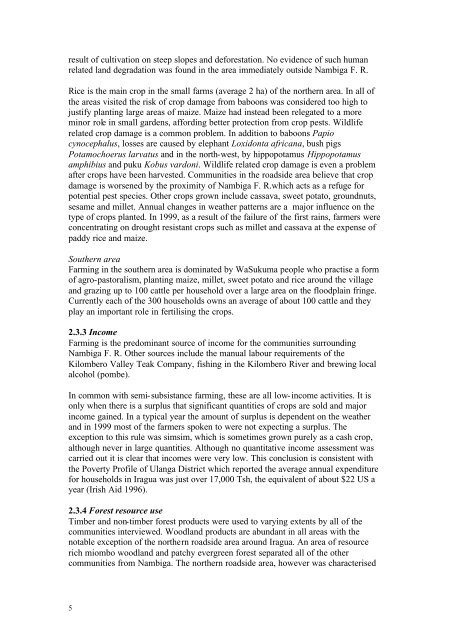Frontier Tanzania Savanna Research Programme
Frontier Tanzania Savanna Research Programme
Frontier Tanzania Savanna Research Programme
You also want an ePaper? Increase the reach of your titles
YUMPU automatically turns print PDFs into web optimized ePapers that Google loves.
esult of cultivation on steep slopes and deforestation. No evidence of such humanrelated land degradation was found in the area immediately outside Nambiga F. R.Rice is the main crop in the small farms (average 2 ha) of the northern area. In all ofthe areas visited the risk of crop damage from baboons was considered too high tojustify planting large areas of maize. Maize had instead been relegated to a moreminor role in small gardens, affording better protection from crop pests. Wildliferelated crop damage is a common problem. In addition to baboons Papiocynocephalus, losses are caused by elephant Loxidonta africana, bush pigsPotamochoerus larvatus and in the north-west, by hippopotamus Hippopotamusamphibius and puku Kobus vardoni. Wildlife related crop damage is even a problemafter crops have been harvested. Communities in the roadside area believe that cropdamage is worsened by the proximity of Nambiga F. R.which acts as a refuge forpotential pest species. Other crops grown include cassava, sweet potato, groundnuts,sesame and millet. Annual changes in weather patterns are a major influence on thetype of crops planted. In 1999, as a result of the failure of the first rains, farmers wereconcentrating on drought resistant crops such as millet and cassava at the expense ofpaddy rice and maize.Southern areaFarming in the southern area is dominated by WaSukuma people who practise a formof agro-pastoralism, planting maize, millet, sweet potato and rice around the villageand grazing up to 100 cattle per household over a large area on the floodplain fringe.Currently each of the 300 households owns an average of about 100 cattle and theyplay an important role in fertilising the crops.2.3.3 IncomeFarming is the predominant source of income for the communities surroundingNambiga F. R. Other sources include the manual labour requirements of theKilombero Valley Teak Company, fishing in the Kilombero River and brewing localalcohol (pombe).In common with semi-subsistance farming, these are all low-income activities. It isonly when there is a surplus that significant quantities of crops are sold and majorincome gained. In a typical year the amount of surplus is dependent on the weatherand in 1999 most of the farmers spoken to were not expecting a surplus. Theexception to this rule was simsim, which is sometimes grown purely as a cash crop,although never in large quantities. Although no quantitative income assessment wascarried out it is clear that incomes were very low. This conclusion is consistent withthe Poverty Profile of Ulanga District which reported the average annual expenditurefor households in Iragua was just over 17,000 Tsh, the equivalent of about $22 US ayear (Irish Aid 1996).2.3.4 Forest resource useTimber and non-timber forest products were used to varying extents by all of thecommunities interviewed. Woodland products are abundant in all areas with thenotable exception of the northern roadside area around Iragua. An area of resourcerich miombo woodland and patchy evergreen forest separated all of the othercommunities from Nambiga. The northern roadside area, however was characterised5
















